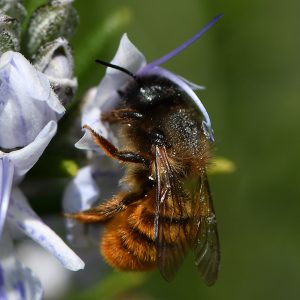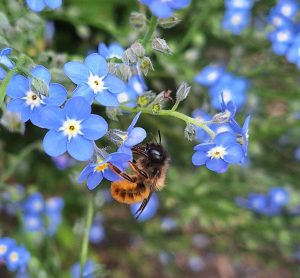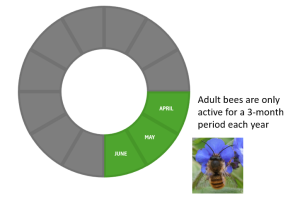Mason Bees
Ireland’s Mason Bees
One third of Ireland’s wild bee species are threatened with extinction from our island. This is mainly because we’ve drastically reduced the habitats that provide them with food and shelter. Other factors include pesticides, pests and diseases, and climate change.
Some wild bees, such as the Red Mason Bee, can be purchased online. The trade in imported pollinators poses a huge risk to our native species. In the short-term, the risks include inadvertently importing pests and diseases that could damage our native populations; or introducing a species that could outcompete rarer native species that are already struggling. In the longer-term, it risks interfering with genetics of native populations that have adapted to conditions on the island of Ireland over many thousands of generations.
The All-Ireland Pollinator Plan asks the public not to import any wild bees or other wild insects into the island of Ireland.
It is vital that we protect our native wild bees by giving them food, shelter, safety from chemicals, and preventing the spread of pests and diseases. Protecting our native pollinators is the most cost-effective way to ensure they are able to provide a pollination service.
What are Mason bees?
A mason bee (also known as a masonry bee) is a term used for any bee in the Osmia genus which are part of the family Megachilidae. They are a type of solitary bee, the largest group of wild bees on the island of Ireland.
On the island of Ireland, we currently have two widespread species of Mason bee:
- The Gold-fringed Mason Bee (Osmia aurulenta) is native to the island of Ireland.
- The Red Mason Bee (Osmia bicornis) recently established since its introduction in 2003.
A third species is known from Ireland but is not yet found across the island. The Blue Mason Bee (Osmia caerulescens) was discovered in Co Down in 2019. There have been subsequent records from this location suggesting it is established there, but it remains extremely rare. It is likely that we might find other Mason Bees on the island of Ireland in the future, as there are around a dozen species known from Britain. Mason Bees are a medium to large sized solitary bee species with a hairy thorax and abdomen. They nest above ground, with the Gold-fringed Mason Bee nesting in empty snail shells.
Gold–fringed Mason Bee (Osmia aurulenta)
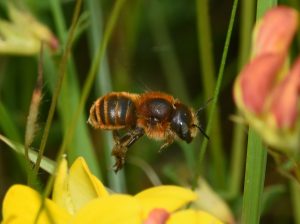 |
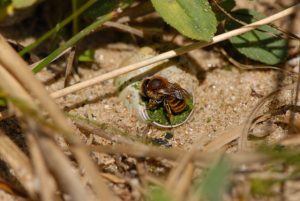 |
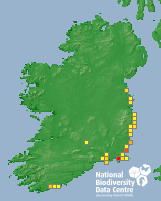 |
- Native species
- A medium sized solitary bee, 7-12mm.
- Flight period is from April to August, peaking in May to June.
- Females have ginger hairs on their thorax and ginger hair bands on the abdomen. Males are often smaller, with greyer hairs on the thorax.
- The only Irish bee that nests inside empty snail shells.
- Almost entirely restricted to sand dunes, and currently only found on the east and south coasts.
- The sole inland population, located in Co. Tipperary nests in peaty soils at the base of heather tussocks.
- This may be our only true native mason bee and was first recorded in 1921.
- As a surface nesting species, it is particularly vulnerable to trampling and compaction pressures even in relatively intact dune systems.
- Females spend a lot of time searching for the best shell to nest in. Male bees set up territory around a snail shell and defend this area in a hope of attracting a mate.
- Loves to feed on Bird’s-foot-trefoil and Kidney Vetch.

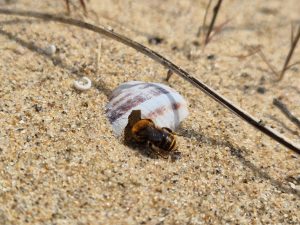
Red Mason Bee (Osmia bicornis)
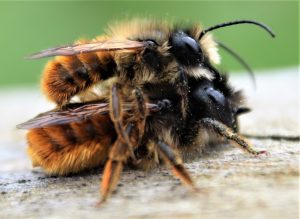 |
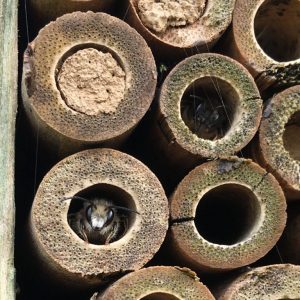 |
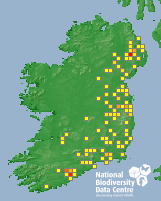 |
- A large sized solitary bee, 10-14mm.
- Spring flying bee, found from April to June.
- Females have brownish hairs on their thorax and reddish hairs on their abdomen, they also have two small black horns projecting outwards from the face. The male is smaller and duller in colour and has a white tuft on the head.
- Nest in cavities, burrows can be in soil, dead wood, the space between roof tiles, holes in soft or crumbling mortar joints and will use bee hotels.
- Red Mason bees are an excellent pollinator of fruits.
- First recorded on the Island of Ireland in 2003 in Dublin City. Originally centred around the cities of Belfast, Dublin and Cork but has now become more widespread, particularly in the east.
- Probably a deliberate introduction as they are commercially available as pupae. However, it is likely that they would have arrived naturally.
You should never import Red Mason Bees into the island of Ireland. It could inadvertently lead to the importation of pests and diseases which could be hugely detrimental to our biodiversity.
Red Mason Bee life cycle
|
Time of year |
Activity |
|
April |
Unfertilised eggs were laid at the entrance of the nest tunnel last year. These emerge as males, typically two weeks earlier than the fertilised eggs, which become female bees. |
|
April/May |
The males wait to mate with the emerging females, who will then start to establish a nest. |
|
|
The males die off after about 6 weeks. |
|
April – June |
The female uses mud to build a linear row of single cells. They gather a mixture of pollen and nectar to create a pollen basket, which is placed in the cell with an egg and sealed in. |
|
April – June |
It takes the female 1 to 1.5 days to build and provision one cell. The eggs hatch in about one week, and the larvae eat the stored pollen and nectar in the cell. |
|
Mid-late June |
The last of the females are active until mid-late June, when nesting activity comes to an end and the nesting tunnels are capped off with mud. The females then die off. |
|
July – September |
At around day 56, the larvae spin a cocoon. They remain in the cocoon for a further 48 days. |
|
Autumn-Winter |
The larvae then go through metamorphosis and turn into an adult bee. They overwinter in tough cocoons as fully formed bees. |
|
|
The bees then remain dormant until they emerge the following spring. |
The below photographs were provided by John Fortune, a beekeeper, who had the Red Mason Bee nesting in one of his hives. He was able to photograph the progression of the nest.
Mason Bees – frequently asked questions
How important are Mason Bees?
Mason bees play an important role in our ecosystems because they are one of the best bee pollinators. It’s all to do with how they carry pollen back to their nest to feed their larvae.
How do Mason Bees carry pollen?
Most bees have evolved to be very efficient at collecting and transporting pollen, storing it on their back legs. However, the Mason and Leaf-cutter solitary bees haven’t evolved to store pollen in this way. The underside of their abdomen is very hairy, and they pack the pollen into these hairs. As they move around, lots fall off and gets dispersed to new flowers, making them excellent pollinators of plants.
Do Mason Bees sting?
Like all bees, only females have a sting. These solitary bees are non-aggressive and rarely sting, as they do not have a queen or hive to protect. They are happy to live and forage close to humans.
Do Red Mason Bees cause structural damage?
Red Mason Bees usually use pre-existing holes and crevices, so they don’t usually cause significant damage to property. They may nest inside old nail holes, irregular cavities in stone, beetle borings in timber or inside spaces under roof tiles.
I have hundreds of Red Mason Bees nesting in my garden. Is this normal?
Where they find suitable nesting areas, Red Mason Bees can be seen in large numbers. Remember, they are not aggressive and have a short life cycle. They will have entirely disappeared by the end of June.
Can I move a colony of Red Mason Bees?
No, solitary bee colonies cannot be moved. You should ensure that there are no potential nest holes in areas of your house where you are not comfortable having them.
Where should I locate a Red Mason Bee hotel in my garden?
Locate your bee hotel in a sunny location and a quieter area of the garden. Remember nest boxes need to be close to flowers so they can feed.
What do I do if I find a Red Mason bee inside my house?
Lift the bee gently onto a piece of paper or place in a container and release it in a quiet area of the garden.
What can I do to help the Red Mason Bees in my garden?
You can help them by providing food and shelter:
- Provide a wide range of native and non-native plants, that flower throughout the spring and summer, such as Dandelion, Forget-me-nots, Blackthorn, Hawthorn/Whitethorn, Buttercups, Holly, Bramble and others. Don’t forget, they’ll also help to pollinate fruiting plants in your garden, such as Apples, Raspberries and Currants.
- Provide a nesting box, find out more here Pollinator-Nesting-How-to-Guide-2022-WEB.pdf (pollinators.ie)
- Avoid the use of insecticides and herbicides.
